
Gasket Replacement Instructions
Learn how to replace and care for the latex gaskets on your drytops and dry suits with these detailed step-by-step instructions.
Materials Needed
- Drysuit Gaskets
- Aquaseal Flexible Repair Adhesive
- Gear Aid Cotol Accelerator & Cleaner (Optional, but recommended)
- Roller Rasp
- Pro Roller
- Sandpaper
- Glossy Nylon Strapping Tape (Masking Tape is not recommended because Aquaseal will stick to it.)
- Masking Tape
- Razor blade and/or Scissors
- Form
- Strong Rubber Bands
- Clean Lint-Free Rag
- Popsicle Stick, small Bristle Brush or Plastic Knife

Step-by-Step Instructions
Caution: New drysuit gaskets may not be comfortable initially but will stretch over time. We recommend stretching new gaskets around something slightly larger than the gasket opening overnight. Trimming the gaskets is not recommended and may cause gasket failure.
Safety First: Always work in a well-ventilated area. Latex gloves, eye protection, and a respirator are highly recommended.
Step 1: Inspect the Old Gasket
If the existing gasket is in good condition, the new gasket can be adhered to the existing gasket. Make sure you leave approximately 1” of old gasket material above the material of the drytop/suit. This will leave plenty of the existing latex to adhere the new gasket to.
Note: Do not cut into the actual material of the drytop/suit; only the latex should be cut.
Completely remove the gasket if it’s dry and cracking or is not completely attached to the drytop/suit. Using a hair dryer to apply heat to the old gasket will weaken the adhesive allowing the gasket to be peeled off. You do not need to clean off the old glue; the new glue layer can be applied over the old.
Step 2: Insert a Form Into the Drytop/Suit
Forms can be coffee cans, pots, or plastic containers. A form can also be made by cutting Minicell foam to the size and shape you need. Before inserting the form, cover it with glossy tape (nylon strapping tape) to prevent the Aquaseal from sticking to the form. The form should fit tightly inside. In the event that a tight fit is hard to achieve, increase the diameter of the form using glossy tape or use a different form.
Note: We do not recommend using cone-shaped forms because they can cause the gasket to slide during the repair.
Step 3: Position The Drytop/Suit
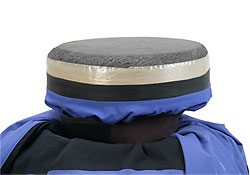
The drytop/suit should be positioned so that 1–2" of the form is exposed above the edge of the gasket material.
Step 4: Stretch the New Gasket Over the Form
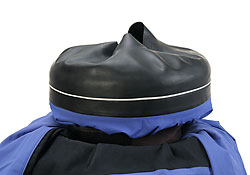
The new gasket should be stretched over the form and pulled down far enough to completely overlap the old gasket, or to where the old gasket used to be. The shiny strip at the bottom of one side of the new gasket is the gluing surface and is placed inside against the old gasket. Place a rubber band over the gasket about half way down the form.
Note: Leave the rubber band in place until the gasket repair is completed.
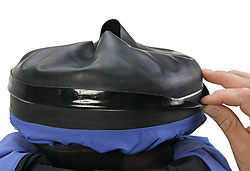
Step 5: Fold the New Gasket Over Itself
Fold the new gasket over itself, and the rubber band, enough to expose the suit’s old gasket underneath.
Step 6: Buff the Old Gasket
Buff the old gasket with 150 or 180 grit wet/dry sandpaper. Rough up the area to be glued until the latex loses its shine. Clean with Cotol or acetone, using a clean lint-free rag.
Note: Many new gaskets now come with a shiny polyurethane strip, which is the gluing surface. This strip does not need to be buffed. Simply clean the strip lightly with Cotol or acetone and continue with the repair.
Step 7: Apply a Thin Layer of Aquaseal
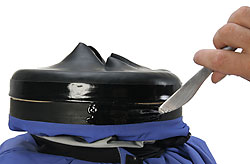
From this point there are different techniques you can use in gluing on your new gasket.
- Mix Cotol with the Aquaseal, 3 parts Aquaseal to 1 part Cotol. Cotol speeds up the cure time to approximately two hours, depending on conditions. Aquaseal is a moisture-curing adhesive, so low humidity slows the cure. We recommend this technique because the mixture is a brushable consistency and the faster cure time lets it act more like a contact adhesive. In the repair shop we use 1/2" chip brushes to apply the glue. Don’t go beyond the 3:1 mixture; too much Cotol can lead to a poor glue bond.
- Apply Aquaseal without Cotol. It’s a thick gel, so you’ll need to spread it with something like a butter knife or popsicle stick.
Whichever method you’re using, spread a thin layer of adhesive over both surfaces.
Step 8: Fold the New Gasket Down
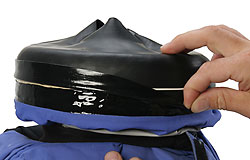
If you’re using Cotol, wait about 30 minutes before folding the new gasket down. This wait allows the glue to partially cure and become tacky. Test it by touching with a knuckle. It should feel tacky, but no glue will come off on your knuckle. Use the roller to press the surfaces together and remove any air bubbles.
If using straight Aquaseal, there are two different ways to approach this step. You can carefully fold the gasket down right away. Use the roller to press the surfaces together and remove any air bubbles. You’ll want to put some more rubber bands over the glued area to keep the surfaces together until the glue cures.
If using straight Aquaseal, alternately you can let the glue cure overnight. Then quickly wipe the surfaces with a rag soaked in acetone. This will create a tacky surface. Carefully fold the gasket down and use the roller to press the surfaces together and remove any air bubbles.
Step 9: Monitor Your Repair
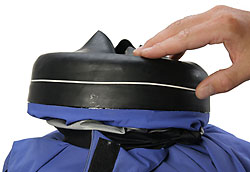
When using straight Aquaseal and folding the gasket down right away, for the first hour check the repair occasionally to make sure the gasket does not slip and that no wrinkles or air pockets develop. Slipping can occur when our form is too big or too small, so pay close attention to how the gasket is sitting during the early curing process.
Note: The optimal climate for repairs is above 60 degrees F and below 50% humidity. Curing time may vary with climate conditions.
When using Cotol with the Aquaseal, full cure usually occurs within two hours, but it’s safer to wait four hours before putting stress on the bond. With straight Aquaseal, full cure can take 8-12 hours.
Step 10: “Seam-Line” (optional)

One way to ensure your gasket repair will stay for a longer period of time is to add a “seam-line” about ¼ to ½ inch wide that will span the gap between the edge of the new gasket and the cloth of your dry suit. Edges are the enemy when it comes to glue. No matter how careful your preparation, you will always be fighting off a peeling edge. We recommend going through the same steps of mechanical prep (sandpaper), chemical cleaning, and an additional step of taping off the “seam-line” area.
Mechanically prep the lowest 1/4" to 1/2" of your new gasket where it meets the drysuit. Going over will not be a big deal, and being neat is not necessary during this step. After you have made the material roughed up, use some acetone or Cotol to clean up this area. These steps are very much the same as prepping the old gasket.
The additional step of taping off your area will help ensure the end product looks nice and clean, not entirely necessary, but it does add a nice touch. Making sure you stay a consistent 1/4" above the seam between the new gasket and the drysuit wrap some masking tape all the way around the neck gasket. Repeat this procedure 1/4' below the seam on the cloth side of your Drysuit. When you are done you will have a nice 1/4 to 1/2 inch piece of drysuit showing through the tape that shows the seam of the new gasket with the drysuit. Coat this seam with glue, immediately remove the tape (it can be very difficult/impossible to remove after the glue has dried) and wait 24 hours.
There is also a seam on the inside of the gasket; you can repeat this procedure by turning that portion of the drysuit inside out, and starting all over. This step is not necessary but it will help your repair last a lot longer.
Gasket Care
Gaskets are made of latex rubber which is highly susceptible to drying out over time. Regular treatments with silicone grease or spray can greatly increase the life of your gaskets. We recommend coating your gaskets every 4-6 weeks when not in use and every time you get off the water.
- Temperature: Storage temperatures should be kept below 80°F and the material stored away from heaters.
- Humidity: Moist storage conditions should be avoided.
- Direct light or artificial UV Light: Articles should be protected from prolonged exposure to
light, in particular direct sunlight and artificial light with a high U.V. content. - Metals: Avoid contact with copper and copper containing alloys.
- Ozone: One of the worst places to store a dry suit/top with latex seals is in the back of a car where high levels of ozone are created locally, in hot weather.
Care should be taken to wash out the gaskets after use in cold water and towel dry. Avoid getting sunscreen on your gaskets; ingredients in some of them will damage the latex.
 NRS Gift Card: Always Fits, Always Wanted
NRS Gift Card: Always Fits, Always Wanted




